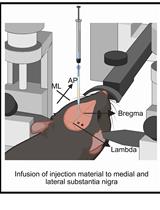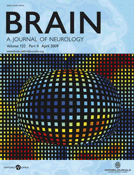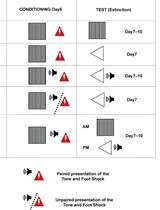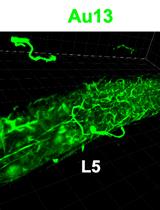- EN - English
- CN - 中文
The Repeated Flurothyl Seizure Model in Mice
三氟乙醚诱导的小鼠反复癫痫发作模型
发布: 2017年06月05日第7卷第11期 DOI: 10.21769/BioProtoc.2309 浏览次数: 8537
评审: Soyun KimEdel HennessyAnonymous reviewer(s)

相关实验方案

基于 rAAV-α-Syn 与 α-Syn 预成纤维共同构建的帕金森病一体化小鼠模型
Santhosh Kumar Subramanya [...] Poonam Thakur
2025年12月05日 1547 阅读
Abstract
Development of spontaneous seizures is the hallmark of human epilepsy. There is a critical need for new epilepsy models in order to elucidate mechanisms responsible for leading to the development of spontaneous seizures and for testing new anti-epileptic compounds. Moreover, rodent models of epilepsy have clearly demonstrated that there are two independent seizure systems in the brain: 1) the forebrain seizure network required for the expression of clonic seizures mediated by forebrain neurocircuitry, and 2) the brainstem seizure network necessary for the expression of brainstem or tonic seizures mediated by brainstem neurocircuitry. In seizure naïve animals, these two systems are separate, but developing models that can explore the intersection of the forebrain and brainstem seizure systems or for elucidating mechanisms responsible for bringing these two seizure systems together may aid in our understanding of: 1) how seizures can become more complex over time, and 2) sudden unexpected death in epilepsy (SUDEP) since propagation of seizure discharge from the forebrain seizure system to the brainstem seizure system may have an important role in SUDEP because many cardiorespiratory systems are localized in the brainstem. The repeated flurothyl seizure model of epileptogenesis, as described here, may aid in providing insight into these important epilepsy issues in addition to understanding how spontaneous seizures develop.
Keywords: Epilepsy (癫痫)Background
Epilepsy is a complex and multifactorial disease defined by unprovoked spontaneous seizures. Approximately two-thirds of the epilepsy population are successfully treated with anticonvulsant drug regimens, but the remaining one third continue to experience seizures (Kwan and Brodie, 2000; Lindsten et al., 2001; Kwan et al., 2010; Loscher et al., 2013; Brodie, 2017). Given the complexities of genetic heterogeneity and inherent difficulties in studying the pathophysiology of epileptogenesis in humans, animal models of epilepsy have served important roles for understanding how spontaneous seizures develop. The mainstays of animal models of spontaneous seizures are either 1) chemically-induced status epilepticus models (SE: a condition characterized by continuous seizure activity) or electrically-induced SE models, or 2) traumatic brain injury (TBI) models. However, there are caveats with these models (Pitkänen et al., 2006). For instance, at least 30 min of SE (but more typically 1-2 h of SE) are required for the appearance of spontaneous seizures with the presence of spontaneous seizures being highly dependent on the duration of SE (Lemos and Cavalheiro, 1995; Gorter et al., 2003; Curia et al., 2008; Loscher, 2013; Kandratavicius et al., 2014; Polli et al., 2014; Gorter et al., 2016). Following these prolonged bouts of SE, there can be a significant increase in mortality (Goodman, 1998; Curia et al., 2008; Scorza et al., 2009; Loscher, 2013; Reddy and Kuruba, 2013; Kandratavicius et al., 2014). Given that SE is a significant seizure event, substantial neuronal death occurs (Goodman, 1998; Curia et al., 2008; Scorza et al., 2009; Loscher, 2013; Reddy and Kuruba, 2013; Kandratavicius et al., 2014). Importantly, both SE and substantial neuronal death are not common findings in most human epilepsies. Lastly, TBI models in rodents also have caveats in that very large regions of the brain require damage to produce spontaneous seizures, and substantial brain damage is not a common observation found in human epilepsy (Pitkänen et al., 2006). Therefore, new rodent models are needed limiting these caveats to continue to advance our understanding of epileptogenesis.
Experimental evidence suggests that there are two largely independent seizure systems that are responsible for the expression of generalized seizures (Kreindler et al., 1958; Browning et al., 1981; Browning and Nelson, 1986; Magistris et al., 1988; Applegate et al., 1991). These two seizure systems are referred to as the forebrain seizure network and the brainstem seizure network. Whereas the forebrain seizure network is responsible for the expression of clonic seizures, the brainstem seizure network is responsible for the expression of brainstem (tonic) seizures (Kreindler et al., 1958; Browning et al., 1981; Browning and Nelson, 1986; Magistris et al., 1988; Applegate et al., 1991). As such, forebrain neurocircuitry modulates the expression of clonic seizures, while brainstem neurocircuitry is both necessary and sufficient for the expression of a variety of tonic-brainstem seizure types. Notably, these seizure systems are mostly independent and the seizures elicited in one network do not readily spread to the other in seizure naïve rodents (Kreindler et al., 1958; Browning et al., 1981; Browning and Nelson, 1986; Magistris et al., 1988; Applegate et al., 1991). Interestingly, BOLD fMRI and SPECT imaging has revealed the critical nature of brainstem structures in the expression of tonic seizures in humans and in animal models (Blumenfeld et al., 2009; Varghese et al., 2009; DeSalvo et al., 2010). However, little is known regarding reorganizations that occur in the brainstem seizure network, or at the intersection of the forebrain seizure network and brainstem seizure network, which can both give rise to brainstem seizure expression.
Flurothyl is a volatile chemoconvulsant acting as a GABAA antagonist that was extensively used historically to induce seizures in severely depressed patients as an alternative to electroconvulsive shock therapy (Krasowski, 2000; Fink, 2014). There are three primary advantages of flurothyl as a chemoconvulsant. First, there are minimal stressors imparted on the rodents since flurothyl is highly volatile. It is infused into a chamber wherein the animal inhales the flurothyl thereby eliminating the need for injections. Second, flurothyl is rapidly eliminated unmetabolized through the lungs, thus eliminating potential confounds of residual convulsant remaining in the body (Krantz et al., 1957; Dolenz, 1967). Finally, flurothyl-induced seizure durations are short (e.g., typically 15-60 sec depending on the seizure type expressed) due to the ease of controlling seizures by simply exposing the animals to room air.
The repeated flurothyl seizure model can be used to understand how seizures develop and become more complex over time, and to explore the mechanistic intersections of the forebrain seizure network and brainstem seizure network that may lead to more complex seizure types (Applegate et al., 1997; Samoriski and Applegate, 1997; Samoriski et al., 1997; Ferland and Applegate, 1998a; 1998b and 1999). With the repeated flurothyl seizure model, C57BL/6J mice express clonic-forebrain seizures during eight flurothyl induction trials (Samoriski and Applegate, 1997; Papandrea et al., 2009). Following a one month incubation period and a rechallenge with flurothyl, C57BL/6J mice express a clonic-forebrain seizure that rapidly and uninterruptedly transitions into a tonic-brainstem seizure (Samoriski and Applegate, 1997; Ferland and Applegate, 1998b). We refer to these seizures as forebrainbrainstem seizures denoting the ictal progression from the forebrain seizure network to the brainstem seizure network (Papandrea et al., 2009; Kadiyala et al., 2015). Lastly, C57BL6/J mice exposed to the repeated flurothyl seizure model rapidly develop spontaneous seizures that appear to remit without treatment following 1 month (Kadiyala et al., 2016), in contrast to DBA2/J mice which also rapidly develop spontaneous seizures that do not remit (Kadiyala and Ferland, 2017). Here, we describe the methods for assaying mice in the repeated flurothyl seizure model, which was originally described 20 years ago (Applegate et al., 1997; Samoriski and Applegate, 1997) and continues to be characterized.
Materials and Reagents
- 18 G needle
- 3 x 3 in. medium gauze pads (CVS, catalog number: 893120 )
- C57BL/6J male mice (6-7 weeks on arrival) (THE JACKSON LABORATORY, catalog number: 000664 )
- Aquarium sealant
- Flurothyl (Bis(2,2,2-trifluoroethyl) ether or 2,2,2-trifluoroethyl ether) (Sigma-Aldrich, catalog number: 287571 )
IMPORTANT: Perform all flurothyl exposures in a certified chemical fume hood with exhaust out of the laboratory, since the inhalation of flurothyl will result in seizures in humans. - 95% ethanol (ethyl alcohol 190 proof) (PHARMCO-AAPER, catalog number: 111000190 )
- Petroleum jelly
- 10% flurothyl solution (see Recipes)
Equipment
- All-clear vacuum Plexiglas desiccator chamber (Ted Pella, model: 2240-1 )
- 20 ml glass syringe (Sigma-Aldrich, catalog number: Z101079 )
- Syringe pump (Kent Scientific, model: GENIE Plus )
- Forceps (for removing the flurothyl saturated gauze pad from the chamber)
- Wire mesh colander with at least ¼” square mesh
- Chemical fume hood
Procedure
文章信息
版权信息
© 2017 The Authors; exclusive licensee Bio-protocol LLC.
如何引用
Ferland, R. J. (2017). The Repeated Flurothyl Seizure Model in Mice. Bio-protocol 7(11): e2309. DOI: 10.21769/BioProtoc.2309.
分类
神经科学 > 神经系统疾病 > 动物模型
您对这篇实验方法有问题吗?
在此处发布您的问题,我们将邀请本文作者来回答。同时,我们会将您的问题发布到Bio-protocol Exchange,以便寻求社区成员的帮助。
Share
Bluesky
X
Copy link











